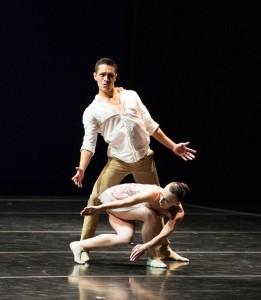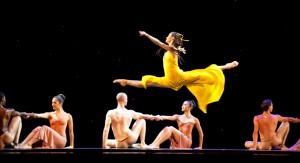The Chicago Dancing Festival continued last night with the Dancing East and West of Chicago program at the Auditorium Theatre at Roosevelt University. Where Monday night’s Chicago Dancing show focused on local talent, Wednesday’s show featured companies from around the country. The East was represented by Brian Brooks Moving Company and Martha Graham Dance Company, both from New York, and the West by Ballet Arizona, San Francisco Ballet (SFB) and Pacific Northwest Ballet (PNB) from Seattle. Not only did the program represent dance companies from coast-to-coast, but the works presented spanned centuries from the 1890 classical ballet (Sleeping Beauty pas de deux) to 2011 postmodern (Brooks’ Descent).
Brook’s piece began with dancers carrying one another across the stage across their backs in a 45-degree plank. The patterns were a meditation in strength and balance, but the most intriguing moments happened with props. Dancers waving flat boards created wind gusts that animated pieces of tulle. The effect was like the movie American Beauty, where the paper bag danced in the wind. Here, the fabric was doing the dancing, while the dancers did the grunt work. It was beautiful. The other New York contingent presented an all-female work about reactions to war. Chronicle (1936) highlights the strength of women with Graham’s signature contractions, pitches, cupped hands and severe drama. The Red Shroud solo performed by Blakeley White-McGuire was particularly intense. Ladies – fierceness be thy name.
A last-minute Midwest addition to the program was Alexander Ekman’s Two Becomes Three performed by two dancers from Giordano Dance Chicago (GDC). Maeghan McHale and Martin Ortiz Tapia danced this quirky duet on Monday night at the Harris Theater. They were delightful then and even better last night. The audience loved them.
Although only one of the three ballet companies performed a work by George Balanchine, they all have ties to the famous Russian choreographer. The artistic directors of Ballet Arizona (Ib Andersen), SFB (Helgi Tomasson) and PNB (Peter Boal) all danced for the company Balanchine founded, the New York City Ballet (NYCB). All three have Balanchine works in their rep and employ dancers that fit in the quintessential Balanchine ballerina mold (read: short waists, long legs, gorgeous feet). His trademark fast footwork and neo-classical style were on full display in the opening number by Ballet Arizona. Rubies, an excerpt from his three-part ballet Jewels (1967) was pertly performed by the petite cast – except for soloist Kenna Draxton, who towered above the rest. The tableau of 15 dancers in a semi circle, dressed in ruby red costumes, hands joined above their heads as the curtain opened was stunning. What followed was a whirlwind of delight. Shout out to Jillian Barrel and Nayon Iovino, quite the dynamic duo.
PNB dancers Lesley Rausch and Seth Orza beautifully performed Jerome Robbins’ Afternoon of a Faun (1953), which is set in an abstract dance studio with the audience serves as the mirror. The haunting score by Claude Debussy lends a melancholic tone to the duet where the dancers seem more interested in their reflections than each other. While this pas was more casual in tone and in dress (leotard and tights with hair down for her, tights and bare-chested for him), the Sleeping Beauty pas de deux, performed by SFB’s Sofiane Sylve and Vito Mazzeo, was full-out formal. Normally danced at the end of the nearly three-hour ballet, this duet represents the marriage of the princess to her prince. The sparkling tiara, tutu and tunic couldn’t out-dazzle this couple. They were spectacular.
There was one slip up – literally – in last night’s show that I must mention, because I think it was the turning point -wow, no more puns I promise – of the show. During the Beauty pas, Sylve slipped and fell. Not just a “whoops!”, but a crash-and-burn on her…um, tutu. The shock of it had made the audience gasp loudly, but Sylve got right up and finished with the grace and talent of the true professional she is. I’m (almost) glad this happened for three reasons. 1. Shit happens – when it does, you get back up and continue on. 2. It proves she’s human. 3. It not only shows the audience, which more than likely had some ballet newcomers in it, that the stage was slick, but if a ballerina of this caliber can fall just walking to the upstage corner of the stage, it shows just how difficult it is be to dance a difficult pas in pointe shoes. The slip upped the respect of the audience tenfold, because she made the rest of it look utterly effortless.


